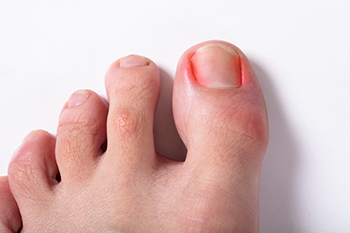 Ingrown toenails can be painful and bothersome, but many non-surgical treatments are available to alleviate symptoms. At the first sign of pain, soaking the affected toe in warm soapy water for up to 20 minutes can soften the skin, allowing you to push it back from the nail edge. Applying antiseptic or anti-inflammatory creams may prevent infection and soothe the skin. A chiropodist can assist with more advanced non-surgical methods, such as using small pieces of sterile cotton to lift the nail away from the skin and securing it with a gauze bandage. Special tools like toenail braces or plastic gutter splints, applied by a chiropodist, can help to keep the nail from pressing into the skin and allow it to grow normally. These treatments typically require patience, as it may take several months for the nail to grow out of the inflamed area. If you have severe pain or notice pus or persistent inflammation, it is advisable to consult a chiropodist immediately. For help in managing an ingrown toenail, it is suggested that you schedule an appointment with a chiropodist for an exam, diagnosis, and treatment.
Ingrown toenails can be painful and bothersome, but many non-surgical treatments are available to alleviate symptoms. At the first sign of pain, soaking the affected toe in warm soapy water for up to 20 minutes can soften the skin, allowing you to push it back from the nail edge. Applying antiseptic or anti-inflammatory creams may prevent infection and soothe the skin. A chiropodist can assist with more advanced non-surgical methods, such as using small pieces of sterile cotton to lift the nail away from the skin and securing it with a gauze bandage. Special tools like toenail braces or plastic gutter splints, applied by a chiropodist, can help to keep the nail from pressing into the skin and allow it to grow normally. These treatments typically require patience, as it may take several months for the nail to grow out of the inflamed area. If you have severe pain or notice pus or persistent inflammation, it is advisable to consult a chiropodist immediately. For help in managing an ingrown toenail, it is suggested that you schedule an appointment with a chiropodist for an exam, diagnosis, and treatment.
Ingrown toenails may require medical attention. If you have significant pain or notice signs of infection from an ingrown toenail, please consult with Cynthia Chan, B.Sc., D.Ch from Healthy Advantage Foot & Orthotic Clinic. Our practitioner will assess your condition and provide you with quality foot and ankle treatment.
What Is an Ingrown Toenail?
An ingrown toenail occurs when the edges of a toenail grow into the surrounding skin. The toenails of the big toe are usually affected, however, an ingrown toenail can happen on any toe. Sometimes, the area can become infected leading to potentially serious complications. The ingrown toenail may be caused by improper trimming of the toenail, wearing ill-fitting shoes, or injury to the nail.
Symptoms
The symptoms of an ingrown toenail include:
-
Pain
-
Swelling
-
Redness
-
Warmth
-
Pus or drainage from the affected nail or a fever may indicate an infection of the area.
Treatment
Treatment depends on the severity of the ingrown toenail. In less severe cases, home treatment may be adequate. Soaking the affected foot in warm water and gently lifting the nail from the skin with a piece of clean cotton can help. In more severe cases, you may need to use topical or oral antibiotics to treat an infection. Surgical removal of the ingrown toenail may be required if more conservative treatments fail.
Ingrown toenails may be prevented by wearing well-fitted shoes and properly trimming the toenails. Toenails should be trimmed straight across and not too short when using nail clippers.
If you have any questions, please feel free to contact our office located in . We offer the newest diagnostic and treatment technologies for all your foot care needs.